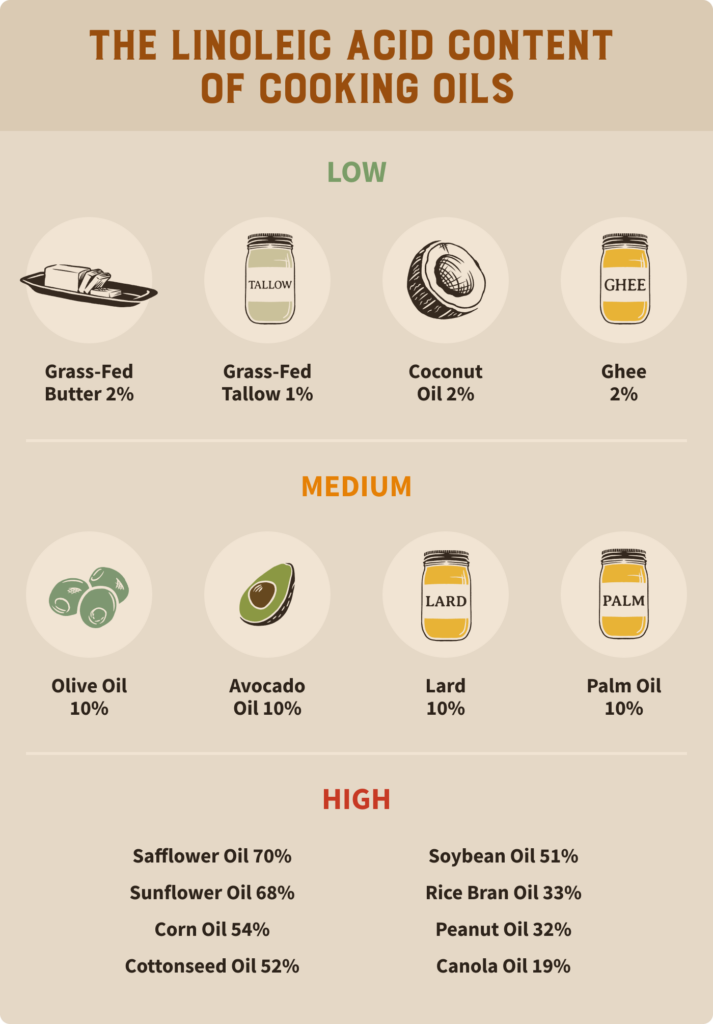PLEASE NOTE: The information in this blog is for educational purposes only. It is not a substitute for professional medical advice. Consult your healthcare provider if you’re seeking medical advice, diagnoses, or treatment.
Seed oils have completely infiltrated the modern food supply. Unless you’re careful, it’s possible that you consume foods with seed oils from shortly after birth until the day you die.
Seed oils, or “vegetable oils,” are extracted from vegetable crops like soybeans, cottonseed, and corn, often through intensive processing. These methods typically involve high heat, chemical solvents, and deodorization to make the oils suitable for consumption.
Seed oils can contain high levels of linoleic acid, an essential omega-6 polyunsaturated fatty acid (PUFA), meaning it has to be obtained through food (1). Linoleic acid is not inherently bad, but the excessive amounts consumed today may contribute to numerous health issues like obesity and other chronic diseases.

Keep an eye out for these oils on ingredient labels:
- Canola oil
- Corn oil
- Cottonseed oil
- Flaxseed oil
- Grapeseed oil
- Hemp seed oil
- Rapeseed oil
- Rice bran oil
- Safflower oil
- Sesame oil
- Soybean oil
- Sunflower oil
As you’ll see, some foods that you’d never expect contain seed oils!
20 Sneaky Sources of Seed Oils
Foods with seed oils are found in just about every section of the grocery store. These are some of the most common hiding places for seed oils:
1. Infant Formulas

Infant formulas in the US are strictly regulated by the Food & Drug Administration (FDA) (2). In order to meet their requirements, manufacturers are required to utilize vegetable and seed oils.
2. Protein Bars & Powders
Many protein powders and bars use ingredients that are less than stellar, including canola and soybean oil.
3. Nuts & Seeds
It may seem like you’re just eating a normal bag of almonds, but popular nut & seed options commonly add a blend of vegetable oils.
4. Peanut Butter

Popular peanut butter tends to also use a blend of vegetable oils.
5. Nut Butters
Often deemed as healthier choices, many nut butters utilize safflower oil, palm oil, or sunflower oil.
6. Granola & Cereal
These breakfast staples generally go hand in hand with a laundry list of ingredients, including canola, sunflower, and peanut oil.
7. Salad Dressing

While there’s dozens and dozens of dressings to choose from, most have a common theme: seed oils are found in their ingredient list.
8. Condiments
Ketchup, mayo, mustard, and other popular condiments frequently contain seed oils.
9. Rice
Microwavable rice packets commonly contain canola or sunflower oil.
10. Crackers & Chips
Some of the most common foods with seed oils are chips and crackers.
11. Coffee Creamer

Soybean oil doesn’t sound that appealing in a cup of coffee, does it? Unfortunately, this combo has become a reality with common coffee creamers.
12. Olive Oil
Double-check your ingredient labels to ensure you’re not buying olive oil mixed with soybean, canola, or other seed oils.
13. Avocado Oil
Similarly to olive oil, some avocado oils are mixed with other oils. Plus, the avocado oil market is ripe with misleading offerings, and some samples of avocado oil even showed that they were almost 100% soybean oil (3).
14. Butter
Foods with seed oils are not always obvious. Butter is a perfect example. Some brands, such as Land O Lakes, add canola oil to certain butter products.
15. Ice Cream
Sticking with the theme of dairy products, ice cream products can contain seed oils. For example, numerous flavors from Ben & Jerry’s include soybean oil.
16. Hummus
Many of the most popular hummus brands use canola or soybean oil.
17. The Whole Foods Hot Bar

Whole Foods is generally viewed as a trusted option for cleaner groceries, but seed oils are in many of their offerings. In particular, food from the hot bar is often prepared with seed oils.
18. Plant-Based Meat
Canola oil is a staple in plant-based meats.
19. Plant-Based Eggs
Just like plant-based meat, egg alternatives (such as Just Egg) use canola oil.
20. Oat Milk
Take a closer look at many of the most popular oat milk options, and you’ll find soybean oil.
How to Avoid Seed Oils
Avoiding seed oils and maintaining a healthy diet can feel like navigating a minefield. A few simple changes can make this journey much more manageable.
- Make your own meals: cooking at home allows you to have greater control over the inputs.
- Choose healthier oils: modern cooking oil can be loaded with polyunsaturated fat (PUFA). Opt for traditional options high in saturated fat like butter, tallow, or coconut oil.
- Eliminate ultra processed food: harmful seed oils are primarily found in highly processed foods like pastries, chips, bread, and pizza.
- Check your labels: seed oils can be found in a wide variety of products. Double check your labels and seek out seed oil free alternatives.
- Use Seed Oil Scout or Local Fats: these tools can help you during travel or find a cleaner restaurant for date night.
Healthy fat choices are crucial, and it’s now common for omega-six fatty acids to far outweigh omega three intakes (4).
Omega three fatty acids are well known for their health benefits, such as improved cognitive function, cardiovascular health, and reduced inflammation (5, 6). Fish and seafood options like salmon, herring, sardines, shrimp, and scallops are valuable sources of omega 3’s.
Exercise Caution: Foods With Seed Oils are Everywhere
Industrial processed seed oils are everywhere, but you can avoid them by searching for cleaner alternatives and double-checking ingredient labels at the store and on items in your fridge or pantry.
Here are several resources to learn more about seed oil consumption:
- The Truth About Seed Oils | FED A LIE | Full Documentary
- Seed Oils and Inflammation — Understanding the Science
- The Hidden Link Between Seed Oils and Chronic Disease
- Are Seed Oils Bad For You? 10 Things You Need to Know
- The 7 Best Healthy Alternatives to Vegetable Oil
Subscribe to future articles like this: